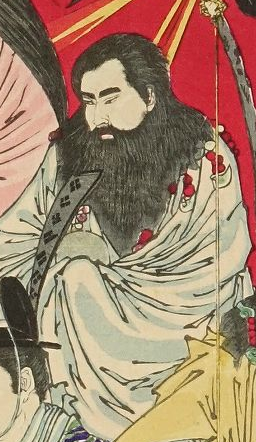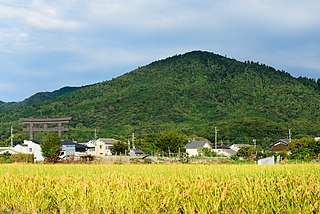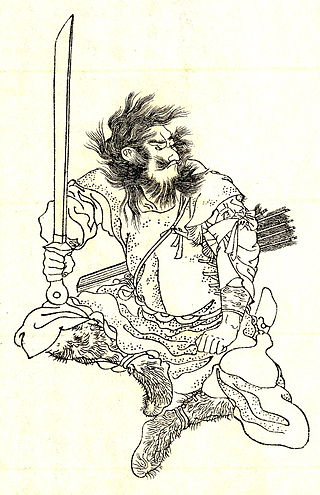
Ōyama-tsumi or Ohoyama-tsumi, also Ōyama-tsumi-mi'oya-no-mikoto (大山祇御祖命), is a god of mountains, sea, and war in Japanese mythology. He is an elder brother of Amaterasu and Susanoo. His other names are Watashi-no-Ōkami (和多志大神) and Sakatoke (酒解神).

Ninigi-no-Mikoto is a deity in Japanese mythology.. Grandson of the sun goddess Amaterasu, Ninigi is regarded according to Japanese mythology as the great-grandfather of Japan’s first emperor, Emperor Jimmu. The three sacred treasures brought with Ninigi from Heaven and divine ancestry established the Japanese Imperial Family.
Umisachi-hiko (海佐知毘古/海幸彦), in Japanese mythology and folklore, was a deity of the bounty of the sea and enchanted fisherman.

Hoori, also known as Hikohohodemi no Mikoto (彦火火出見尊), is a figure in Japanese mythology, the third and youngest son of Ninigi-no-Mikoto and the blossom princess Konohanasakuya-hime. He is one of the ancestors of the Emperors of Japan as the grandfather of Emperor Jimmu. He is also known as Yamasachi-hiko (山幸彦).

Toyotama-hime is a goddess in Japanese mythology who appears in Kojiki and Nihon Shoki. She is the daughter of the sea deity, Watatsumi, and the wife of Hoori. She is known as the paternal grandmother of Emperor Jimmu, the first emperor of Japan.

Ugayafukiaezu no Mikoto (鵜葺草葺不合命) is a Shinto kami, and is in Japanese mythology, the father of Japan's first Emperor, Emperor Jimmu.

Mount Miwa or Mount Mimoro is a mountain located in the city of Sakurai, Nara Prefecture, Japan. It has been an important religious and historical mountain in Japan, especially during its early history, and serves as a holy site in Shinto. The entire mountain is considered sacred, and is home to one of the earliest Shinto shrines, Ōmiwa Shrine. Several burial mounds from the Kofun period can be found around the mountain.
Watatsumi, also pronounced Wadatsumi, is a legendary kami, Japanese dragon and tutelary water deity in Japanese mythology. Ōwatatsumi no kami is believed to be another name for the sea deity Ryūjin and also for the Watatsumi Sanjin, which rule the upper, middle and lower seas respectively and were created when Izanagi was washing himself of the dragons blood when he returned from Yomi, "the underworld".

In Japanese mythology, the tenson kōrin (天孫降臨) is the descent of Amaterasu's grandson Ninigi-no-Mikoto from Heaven (Takamagahara) to Ashihara no Nakatsukuni; according to legend, the direct place of descent is at Takachiho-gawara in Japan. Following the tenson kōrin, Ninigi's son, Hoori, was born.
Tamayori-hime is a goddess in Japanese mythology. Her name is spelled as 玉依毘売命 in the Kojiki and 玉依姫 in the Nihon Shoki.

Amenooshihomimi (天忍穗耳尊,天之忍穂耳命) or Oshihomimi for short, is the first son of Amaterasu.
Takamimusubi is a god of agriculture in Japanese mythology, who was the second of the first beings to come into existence.
Iwanaga-hime is a kami in Japanese mythology. She is also the daughter of Ōyamatsumi, and sister to Konohanasakuya-hime. She is said to be enshrined at Kifune Shrine.
Hosuseri (火須勢理命) is a god that appears in Japanese mythology. Second child of Ninigi-no-Mikoto and Konohanasakuya-hime. He is considered to be the great-uncle of Emperor Jimmu.
Ahiratsu-hime was the first wife of Emperor Jimmu, first Emperor of Japan. Jimmu later married Himetataraisuzu-hime who became the first Empress of Japan, and whose children inherited the throne. Her son Tagishimimi would attempt to seize power violently due to not inheriting the throne.
Inahi no Mikoto was a Japanese legendary character. In Japanese traditional mythology, he was a brother of Emperor Jimmu, the first Emperor who according to tradition lived in the 7th century BC. His name Inahi means "boiled rice".
Takuhadachiji-hime (栲幡千千姫命), is a deity that appears in the creation story of the "Kojiki" and "Nihon Shoki." She is the daughter of the god Takamimusubi and younger sister of Omoikane. She is the goddess of textiles and mother of Ninigi-no-Mikoto and Amenohoakari, and thus an ancestor of Jimmu.

Itsuse no Mikoto is a Japanese deity. He was the older brother of Emperor Jimmu.
Mikeiri no Mikoto is a Japanese deity. He was the older brother of Jimmu.. While playing a minor role in the Nihon Shoki, he has a prominent local tradition at Takachiho Shrine of which he is the main deity. There is an annual festival for him called Shishikake Festival.
Konohanachiru-hime is a Japanese goddess.














